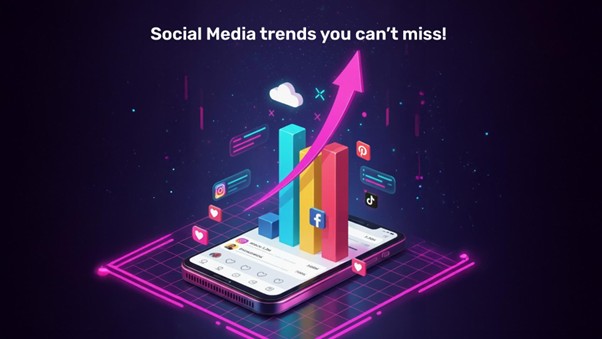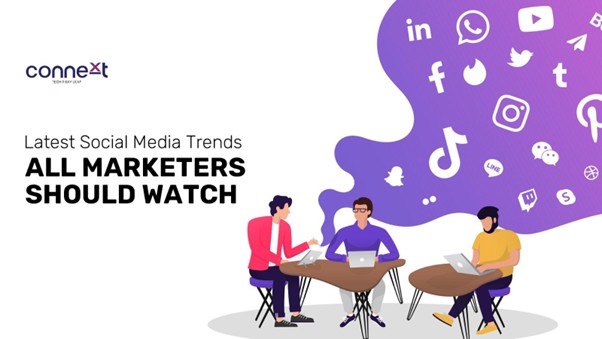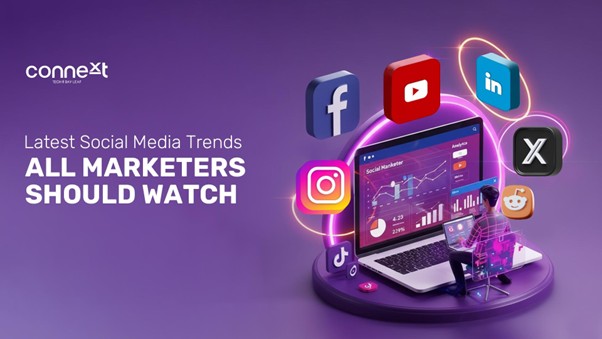Social media has never stood still. Each year, platforms reinvent themselves, whether it’s the rise of Stories, the explosion of Reels, or the shift toward AI-driven personalization. In 2025, the pace of change is faster than ever, reshaping the future of social media marketing.
The latest social media trends in 2025 reveal a clear shift toward AI-driven personalization, the dominance of short-form video, and deeper brand–community engagement. For marketers, this means focusing on authentic content, leveraging data insights, and adopting emerging platforms to stay competitive. In this guide, we’ll break down the top trends every marketer should watch, with practical tips to help you boost reach, engagement, and ROI. Fall behind, and competitors will capture attention, trust, and wallet share before you even notice.
That’s why this guide is a must-have for all marketers in 2025. Here, you’ll find actionable trends backed by data and examples, showing not only what’s changing but how you can adapt. From short-form video marketing to AI in social media marketing, these are the latest social media trends that will define 2025 and practical steps to turn them into results.
Short-form Videos Are Still Trendy
With information consumption at an all-time high and attention spans at an all-time low, platforms like TikTok and features like Instagram Reels and YouTube Shorts continue to lead the way. They give audiences exactly what they’re looking for—whether it’s something useful or simply entertaining—in quick, bite-sized clips. The real challenge for marketers is to master saying more with less, an art that can make or break a brand in 2025.
Why Bite-Sized Content Drives Higher Engagement
Shorter attention spans call for shorter content. In a world where people scroll at lightning speed, snackable videos are more likely to be watched, remembered, and shared. Platforms like TikTok, Instagram Reels, and YouTube Shorts have perfected the formula: quick bursts of content that deliver value or entertainment without testing anyone’s patience.
Short videos also work because they’re low-effort but high-impact. They also receive 2.5x more engagement than long-form videos. Take Duolingo, whose TikTok has racked up millions of followers with nothing more than a green owl plushie, a phone camera, and some well-timed captions. No fancy gear. No overthinking. Just quick, relatable content that sticks.
For marketers, this format is a win-win. It’s cheaper and easier to produce than long-form, and it can be repurposed across platforms to meet audiences wherever they are. Plus, every video stands on its own since there’s no storyline to follow and no commitment required. Viewers can jump in, watch, move on, and still remember your brand.
That’s the power of bite-sized content: it respects time, builds trust, and keeps engagement high. The best part? It’s affordable.
Actionable tips for brands (repurposing, storytelling, UGC)
Short-form content may be fast, but making it work takes strategy. Here’s how brands can use it to build reach and relevance:
I. Repurpose Smartly
You don’t need to reinvent the wheel every time. Stretch the life of what you already have—break a long webinar into bite-sized clips, convert a blog stat into a quick visual, or slice highlights from a full video into Reels or Shorts. Repurposing multiplies your content output, keeps your feed lively, and saves both time and money.
II. Tell Micro-Stories
Every short-form video should deliver one clear hook, one message, and one takeaway. Keep it under 60 seconds, add captions for silent scrollers, and tailor the format to the platform. Think of each clip as a mini story that’s complete on its own.
III. Lean Into UGC
User-generated content adds instant authenticity. Encourage your audience to share their take—through reviews, challenges, or hashtags—and spotlight their posts on your channels. It builds trust, strengthens community, and amplifies your reach at little to no cost.
When brands combine these three elements (repurposing, storytelling, and UGC), the result is content that’s easier to create, more authentic, and far more likely to resonate.
Rise of AI-Powered Content Creation & Personalization
Artificial intelligence is no longer just a test run in marketing—it has become the engine behind how content is created, distributed, and tailored to audiences. Among the most impactful social media trends of 2025, AI is helping brands launch campaigns that are smarter, faster, and more relevant than ever. From automating copy to delivering personalized recommendations, AI is reshaping engagement at scale. Companies that adopt these tools are also seeing tangible results, with many reporting a 10–20% boost in ROI from AI-driven strategies.
How AI tools streamline social media workflows
Before AI, marketers spent hours brainstorming captions, resizing images, or guessing at posting schedules. Today, AI in social media marketing automates these tasks. Tools can instantly suggest hashtags, test different ad creatives, and even predict audience engagement patterns. This streamlining not only saves time but also allows teams to focus on storytelling and strategy, the areas where human creativity still leads.
Personalized experiences based on behavior & interests
With data-driven insights, AI can deliver personalized content strategies tailored to each user’s preferences. Imagine scrolling through a feed where every ad, product recommendation, or video feels relevant. That’s the power of AI personalization. It can turn mass marketing into one-to-one conversations that deepen brand loyalty.
Risks & best practices for using AI ethically
AI comes with responsibilities. Relying too heavily on automation can erode authenticity, and data misuse risks damaging trust. Marketers must follow best practices: disclose AI use, safeguard customer privacy, and keep a human presence in conversations. Ethical AI use not only avoids risks but also builds credibility in an era where audiences value transparency.

Other Social Media Trends to Watch in 2025
AI and short-form video may be leading the conversation, but they’re not the whole story. Several other latest social media trends are emerging in 2025:
Influencer Marketing Evolves into Long-Term Partnerships
The days of one-off sponsored posts are giving way to authentic, ongoing collaborations. Influencer marketing trends in 2025 show creators acting more like brand partners in co-developing products, building communities, and providing consistent engagement. This approach increases trust and delivers stronger ROI for brands.
Connext by Tech Bay Leaf helps brands cut through the noise by simplifying creator discovery, outreach, and campaign management. Whether it’s teaming up with micro-influencers to spark early traction or scaling into larger partnerships, Connext, an influencer marketing agency in the US, equips startups with the tools to run authentic, data-driven campaigns that build credibility fast.
Social Commerce Redefines Shopping
Shopping habits are changing fast, and social commerce in 2025 is bringing the store directly into the scroll. With livestream shopping, interactive ads, and AR try-ons, the line between browsing and buying has blurred. Marketers who adapt their social media marketing strategies for seamless in-app transactions will stay ahead of the curve. Shopping on social media is moving from trend to habit. By 2025, as many as one in four online buyers are expected to make purchases directly through platforms, reflecting a projected 25% penetration rate. The global market, worth $1.3 trillion in 2023, is expected to rise to $8.5 trillion by 2030. Gen Z gravitates toward Instagram, YouTube, and TikTok for discovery and purchases, while Facebook continues to play a strong role across older demographics. Notably, more than 60% of U.S. shoppers say they’ve bought something after first spotting it on social media.
Rise of Community-Driven Marketing
Consumers no longer want to just consume—they want to belong. Community-driven marketing turns audiences into co-creators, advocates, and collaborators. Private groups, branded forums, and exclusive digital communities are gaining importance, allowing brands to foster deeper connections and organic growth.
Growth of Emerging & Niche Platforms
New social media platforms in 2025 are carving out specialized spaces. Decentralized networks like Mastodon and Bluesky are gaining traction among users who value transparency and privacy. Audio-first apps like AirChat are redefining real-time conversations. Even purpose-driven platforms like WeAre8 are attracting communities that prioritize ethical advertising and sustainability. For marketers, these spaces offer early opportunities to experiment, build authentic communities, and connect with trendsetters before the mainstream catches up.

The Bottom Line: Staying Ahead in 2025
The future of social media marketing is about leveraging the latest social media trends that align with your brand and audience. AI-powered personalization, short-form video marketing, social commerce, and community-focused strategies are reshaping how brands engage online. Experimenting early with niche platforms and building lasting influencer partnerships can provide a meaningful advantage.
FAQs
AI-powered personalization, the dominance of short-form video, evolving influencer partnerships, social commerce growth, and community-driven marketing are the leading trends in 2025.
Short-form video delivers entertainment as well as information in bite-sized chunks to match shrinking attention spans. It also drives 2.5x higher engagement than long-form and is cost-effective to produce and repurpose across platforms.
AI is taking over repetitive tasks like writing captions, picking hashtags, and testing ads, while also tailoring content to each user’s interests. This saves marketers time and also boosts ROI by 10–20%.
In 2025, influencer marketing plays a bigger role than just boosting visibility. Creators are now building long-term partnerships with brands and co-developing products, strengthening trust, and keeping audiences engaged.
Brands can focus on creating short-form video, using AI tools, investing in social commerce, building online communities, and testing new niche platforms early to stay ahead.


